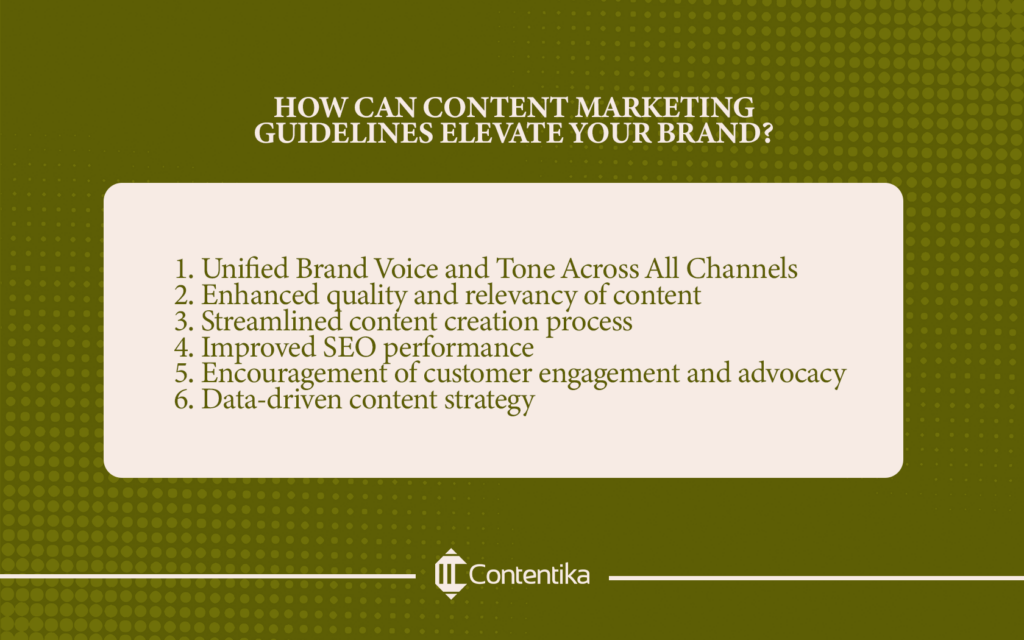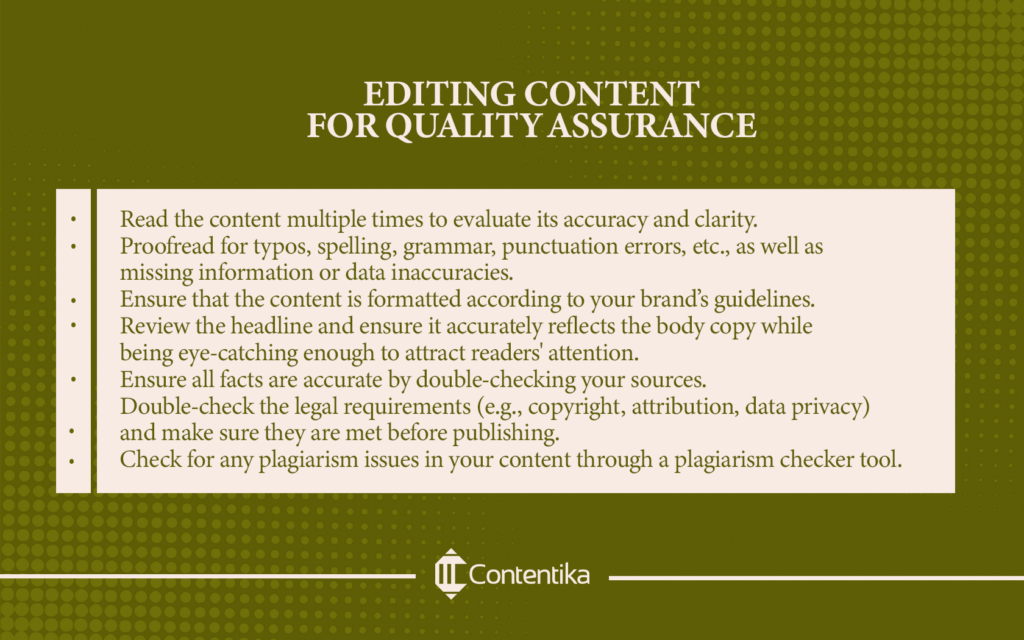Crafting compelling blog content that engages readers and drives traffic to your website can be a daunting task, especially in today’s saturated digital landscape. To create effective content that stands out from the competition, it’s crucial to have a set of blog content guidelines to follow. These guidelines will help ensure that your blog posts are high-quality, valuable, and resonate with your target audience.
In this article, we’ll explore the key elements of successful blog content and provide practical tips and guidelines for creating engaging and informative posts. Whether you’re a seasoned blogger or just starting, our guidelines will help you create content that meets your business goals and satisfies your readers.
By following our guidelines, you can take your blog to the next level and establish your brand as an authority in your industry. So, let’s dive in and learn how to create compelling blog content that drives results!
What Are Content Guidelines?
Content guidelines are essential rules and regulations that govern the creation of content in organizations. They aim to ensure that all content is of high quality, accurate, and consistent.
These guidelines typically cover aspects such as style, tone, grammar, punctuation, formatting; visuals, length, legal requirements, and topics to avoid, among others, ensuring that each piece of content is appropriate for its intended audience and purpose.
Sticking to these rules is important if you want to make professional, effective content that gets the message across. By following these guidelines, content creators can ensure that their content meets the required standards and resonates with their target audience.
Whether you are a seasoned content creator or just getting started, these guidelines can be a valuable tool in helping you create compelling content that meets your business goals.
How Can Content Marketing Guidelines Elevate Your Brand?

Content marketing is more than just creating engaging pieces for your audience; it’s also about promoting your brand consistently and professionally. Establishing content marketing guidelines can help content marketers shape the tone and voice of their content and ensure that it aligns with the brand image.
This not only helps maintain the consistency of your brand but also elevates its image. Here are ways in which content marketing guidelines can elevate your brand:
1. Unified Brand Voice and Tone Across All Channels
Content marketing guidelines provide a framework that ensures your brand communicates consistently across all marketing channels. This consistent voice helps build brand trust and recognition as it maintains the same tone and messaging through blogs, social media, email campaigns, and other forms of promotion.
As a result, your audience easily recognizes and connects with your brand, leading to an increase in customer loyalty and conversions.
2. Enhanced quality and relevancy of content
Guidelines help establish a clear direction for content creation teams, ensuring they understand the customers and their needs. High-quality, relevant content resonates with the audience and addresses their pain points, helping them relate to the brand.
This connection creates an emotional bond that leads to higher brand affinity, better conversion rates, and increased customer retention.
3. Streamlined content creation process
With well-defined guidelines, your content creation team can work more efficiently, knowing the specific objectives, audience, and messaging requirements. This streamlined process guarantees that your marketing efforts are not wasted on redundant, irrelevant, or off-brand content, leading to cost savings and a faster time-to-market.
Having your content calendar and workflow planned ahead in this way also helps you maintain a consistent publishing schedule and ensure that no crucial steps are missed.
4. Improved SEO performance
Using the right keywords and phrases based on research and analysis is a key part of the content marketing guidelines. By focusing on SEO best practices, you can get more targeted traffic and leads to your website through organic reach.
It also strengthens your brand’s online visibility, further solidifying its authority and credibility in the minds of both customers and search engines.
5. Encouragement of customer engagement and advocacy
By consistently creating content that resonates with your target audience, you encourage them to share it, talk about your brand, and become advocates. This organic word-of-mouth advertising is invaluable as it amplifies your brand’s reach and reputation, paving the way for steady growth and expansion.
6. Data-driven content strategy
A well-developed content marketing guideline is a product of adequate research. Thus, it provides crucial insights into customer preferences and behavior. This data-driven approach lets your brand keep refining and improving its content strategy based on what your audience says and how they interact with it.
Using insights from data analysis in your content on a regular basis keeps it relevant and useful, which leads to better results and higher returns on marketing investments.
The Key Elements of Effective Content Marketing Guidelines
Developing an effective content marketing strategy is essential for success. Your writers need to know the basics of your brand, purpose, and audience personas before moving on to the finer details. Knowing what type of content should be created, who will create it, and how they should do so are crucial elements in creating successful content.
To ensure that writers can produce quality work, you need to provide them with detailed rules and regulations for creating content. This includes everything from brainstorming topics to writing the actual content.
By providing these guidelines, writers can craft engaging content tailored to your audience, increasing its reach and effectiveness. Additionally, having a set of clear guidelines ensures that all team members are on the same page about your content-making process. This will help ensure a consistent brand message and quality of work across the board.
With all this in mind, let’s explore what should be included in your content guidelines.
Research
Research should be at the heart of every content piece. Writers should research topics thoroughly before writing and ensure that all information is accurate and up-to-date. Content guidelines should provide guidance on how to conduct efficient research and what resources are available for reference.
Companies should also know their competitors and industry trends to create unique content.
Tone & Voice
An important part of content guidelines is dictating the tone and voice used in your branded content. Tone and voice give your brand its personality, and it’s important to define the two so that all creators know how to write for your brand and maintain consistency across all pieces.
This includes choosing the level of formality, language, humor, attitude, etc. to use when writing content. Define the purpose of each piece of content, as this will help determine the tone and voice used.
Headlines & Copy
Headlines are often the first thing potential readers will see, so it’s important to ensure they’re eye-catching and informative. Content guidelines should tell writers how to write good headlines that will draw people in and make sure that the body copy is also interesting and compelling.
Writers should also be aware of the length and actionable takeaways, which will help readers better understand and retain the content.
Structure & Formatting
Structure and formatting are key components of any style guide and must be outlined accurately for writers to produce high-quality work. Instructions should be clear and to the point so that everyone on the team can easily look them up when making content.
This could include how long a blog post should be or what type of formatting needs to be used for sales pages. It helps ensure the quality and consistency of the content and makes each piece easier to read.
Grammar & Punctuation
Grammar and punctuation rules must be established to keep content polished and professional. Writing guidelines should ensure these rules are communicated effectively without room for ambiguity or interpretation.
Additionally, they must consider regional variations in word choice or spelling (such as American vs. British English).
Visuals
Visuals play an integral role in digital marketing, so companies must develop visuals as part of their branding strategy and content production process. Every brand’s style guide should include details about which colors, fonts, logos, etc., should be used across all platforms, including print materials, websites, social media, etc. so that everything looks cohesive and professional regardless of who creates it or where it is published.
Brand guidelines should also guide the use of images, videos, infographics, etc. and list any associated copyright and legal requirements (e.g., attributions).
Suppose there is a design team involved within the company. In that case, those teams should collaborate closely with content creators during production to create unique visuals that support and enhance the content’s message.
Length
Content guidelines must clearly outline the ideal length for certain types of content. For example, the ideal length for a blog post may differ from that for an email campaign or posts on social platforms. For blog posts, 500–1500 words is a good starting point; for social media posts, around 140–250 characters, depending on the platform. This helps writers create content that is neither too long nor too short.
Topics to Avoid
While creating content guidelines, it’s vital to include topics you don’t want your team members to write about. This ensures that writers clearly understand where they should and shouldn’t tread when crafting pieces related to your brand’s image.
Companies may decide not to write about certain politically charged topics or industry competitors to maintain their credibility and reputation with their readership base.
Legal Requirements
It is equally important for companies to understand the legal requirements before publishing any content on their site or other platforms, such as social media outlets.
Content producers should be aware of copyright laws surrounding using existing content from other sources and data privacy regulations when collecting user information from customers or prospects through their web pages or other digital marketing channels like email newsletters.
Companies must also ensure that their design teams follow all applicable laws before producing materials like logos or trademarks used in their branding efforts.
Keywords & SEO
Writers should consider keywords when crafting content to ensure it appears in search engine results and ranks highly in search engine optimization (SEO). Content guidelines should include a list of each piece’s target keywords and other related words and phrases that could be used in the writing process.
Links & References
To ensure the content quality is the same everywhere, writers must use links and references correctly when getting information from outside sources or referring to existing content on the company website or blog post.
This will help create a strong foundation for readers who can easily navigate between different sections of your website while maintaining accuracy in the information being shared by you as a brand across multiple platforms and channels.
Additionally, including credible links will help search engine optimization (SEO) efforts by boosting trustworthiness signals, ultimately resulting in a higher ranking in SERPs (search engine result pages).
By having a clear and concise content marketing strategy, you can create high-quality content with consistent messaging that increases conversions. This will help build customer trust, loyalty, and advocacy as your brand image is elevated through consistent content that resonates with its target customers.
Editing Content for Quality Assurance
Once the content is written, reviewing and editing the work for quality assurance is essential. This ensures that all pieces meet the brand’s standards in terms of accuracy, clarity, tone of voice, structure, formatting, etc. before publication.
Here are some tips to ensure efficient editing:

- Read the content multiple times to evaluate its accuracy and clarity.
- Proofread for typos, spelling, grammar, punctuation errors, etc., as well as missing information or data inaccuracies.
- Ensure that the content is formatted according to your brand’s guidelines.
- Review the headline and ensure it accurately reflects the body copy while being eye-catching enough to attract readers’ attention.
- Ensure all facts are accurate by double-checking your sources.
- Double-check the legal requirements (e.g., copyright, attribution, data privacy) and make sure they are met before publishing.
- Check for any plagiarism issues in your content through a plagiarism checker tool.
Conclusion
Developing effective content marketing guidelines is essential to creating successful content that resonates with your target audience. Following the tips outlined in this guide, you can set up a framework to ensure your content creation process is efficient and effective. This will help you save time and money while ensuring your content is of the highest quality.
To dive deeper into content marketing, check out our other resources. Doing so can further strengthen your understanding of content marketing strategies and help you create compelling content that will drive steady growth for your business.












